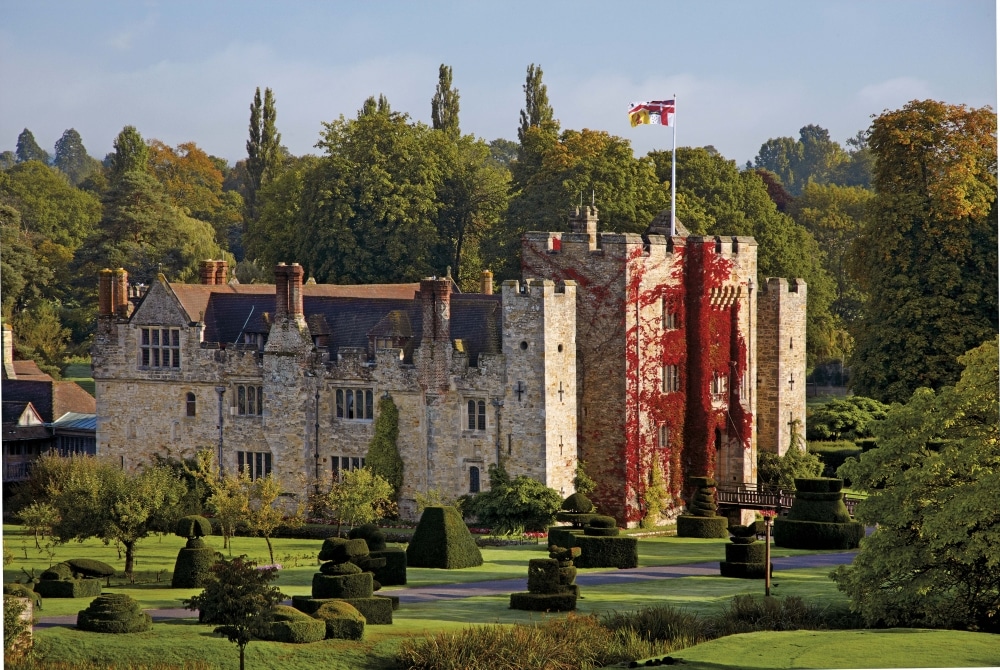For the past 17 years Neil Miller has been head gardener at Hever Castle & Gardens. During that time he has overseen the creation of fantastic garden spaces like the newly created ‘Faith’s Garden’ on Diana’s Walk which contains 1,200 square metres of perennial plants.
The gardens at Hever are substantial and diverse, ranging from the ornate Italian Garden complete with an impressive Loggia and Pompeiian Wall created by William Waldorf Astor at the turn of the 20th century, to the Rose Garden, Tudor Garden, Blue Corner, Two Sisters Lawn with its impressive long border, and Lake Walk.
There’s something to enjoy every season at Hever starting with February’s pretty snowdrops, the Dazzling Daffodil festival in March, April’s special Tulip Celebration and then the glorious roses of Hever in Bloom during the summer months.
Autumn, however, is a unique time at Hever thanks to the fact it’s ablaze with rich colour pretty much everywhere you look. The castle itself is bedecked with red Boston Ivy leaves while the grounds’ numerous tree species boast leaves turning into a riot of gold and red. The mighty oak trees are dropping their acorns in the woods and the numerous themed gardens are full of jewel-like seeds, ready for collecting.
With this in mind Neil Miller is planning to take visitors on a tour of Faith’s Garden to show the perennials in all their glory and to give an informal instruction in seed collecting. Children will also be encouraged to take a Leaf & Seed Collecting Challenge and to take a bulb home to plant.
Neil Miller’s guide to collecting and storing seeds
“Growing from seed may have been on the wane for many years but it remains the best way to increase the number of plants you have in your garden for free.
Seeds can be collected and saved from trees, shrubs, perennials, alpines, vegetables and herbs, at different times in the year, but as the head gardener of a site that holds thousands of garden-worthy hardy perennials, I’ll be concentrating my seed-collecting efforts during this month and camping out in Faith’s Garden – Hever’s fantastic perennial border.
Unsurprisingly, like their plant parents, seeds come in all shapes and sizes and need careful handling during the sorting and drying process. Some, like grasses, are fluffy and a simple pinch works. Others such as peonies are so big they are easy to count individually and put into an envelope.
You don’t need many tools to collect seeds effectively, just dry hands and a dry bowl. You’ll need paper bags, or envelopes (you can recycle your old ones) to pack the seeds and it’s a good idea to use a spare refrigerator or a cool place to store them.
It’s an obvious thing to say, but it’s hugely important that all seed envelopes are labelled properly. If you’re anything like me and find it hard to remember what you were up to six months ago, then labelling will save you from getting yourself in a pickle come spring!
I’ll be leading visitors on tours of Faith’s Garden on Tuesdays and Wednesdays during the month of October as part of Hever Castle’s Autumn Colour event.
I hope to be able to point out good, viable parent plants, and will take my bowl along so we can collect seeds and take them to the Garden Exhibition on site to dry them.”
How to collect seeds
Pick a healthy and vigorous plant to collect from
Don’t collect too soon – immature seeds will not germinate
Collect on a dry day
Look for seed pods which have changed colour from green to brown
Cut or pick the seed heads and lay them out to dry somewhere warm
If the pods aren’t fully open, then wait until they have dried, then gently crush the pods/capsules to release the seeds
Some seed heads explode and need to be checked every day. You can place them in a brown paper bag and wait for them to explode, or shake them.
Once the seed is free, make sure you clean off the chaff to prevent the seeds from rotting.
How to store seeds
Most seeds can be kept to sow in the spring (hellebores are an exception and prefer to be sowed immediately).
Use paper packets (or spent envelopes) and label them correctly.
Keep them in a Tupperware or airtight container with silica gel to absorb excess moisture.
It’s good to store seeds at 5C as they can remain viable for long periods if refrigerated.








